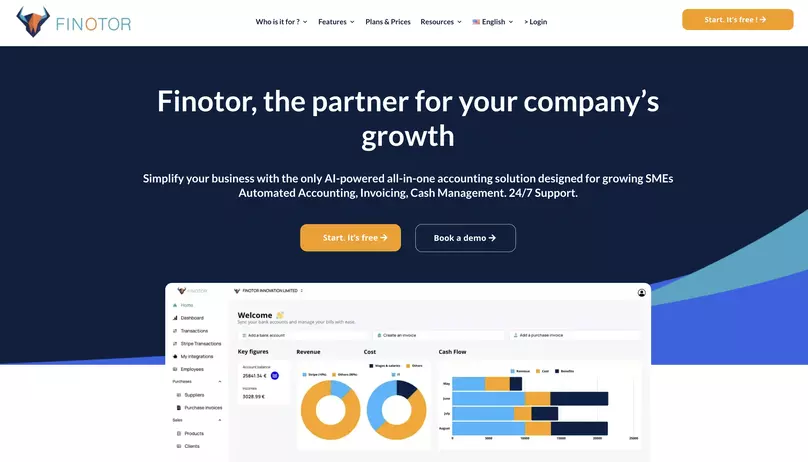Contents
- 1 Understanding the Landscape of Accounting Software Pricing
- 2 Key Features and Their Impact on Pricing
- 3 Factors Influencing the Total Cost of Ownership (TCO)
- 4 Choosing the Right Accounting Software for Your Business Budget
- 5 Factors Influencing the Total Cost of Ownership (TCO)
- 6 Choosing the Right Accounting Software for Your Business Budget
Understanding the Landscape of Accounting Software Pricing
In 2023, the landscape of accounting software is evolving rapidly, with cloud-based solutions and subscription models becoming the norm. Businesses looking to manage their finances effectively must navigate a myriad of pricing options to find a system like Finotor, that matches their needs without compromising on quality or financial sustainability.
The Shift to Cloud-Based Solutions and Subscription Models
The traditional one-time purchase of accounting software is being overtaken by the flexibility of cloud-based solutions. This shift allows for real-time data access, regular updates, and enhanced collaboration. Subscription models associated with these cloud solutions often mean predictable monthly or annual costs and lower upfront investments, which is a significant advantage for businesses managing cash flows. Understanding this shift is crucial for making informed decisions, and a thorough guide can be found at Software Advice’s accounting software pricing guide.
Evaluating Cost vs. Features: What’s Essential for Your Business?
When considering accounting software, businesses must evaluate the balance between cost and features. Essential functions might include invoicing, expense tracking, and financial reporting, but additional features like advanced analytics can drive up costs. It is important to assess which features are truly necessary for your business operations and which might be considered a luxury. For a comparison of essential features and their associated costs, NerdWallet’s review of the best small business accounting software is an invaluable resource.
Comparing Entry-Level, Mid-Range, and Enterprise Software Costs
Accounting software costs can vary widely depending on the scale of the business and the complexity of financial operations. Entry-level solutions may be adequate for small businesses with straightforward accounting needs, while mid-range software might provide the right balance of functionality and cost for growing companies. Large enterprises, however, may require more robust, feature-rich systems that come with a higher price tag. Detailed cost comparison is essential to choose a solution that not only fits today’s needs but also accommodates future growth.
This initial section sets the stage for understanding the dynamic pricing environment of accounting software in 2023, highlighting Finotor as a prime example of an integrated financial management tool poised to meet modern business demands.
Key Features and Their Impact on Pricing
As we delve into the various aspects of accounting software costs in 2023, it’s vital to understand how key features impact the overall pricing. Businesses need to balance the functionalities they require with the price they are willing to pay. Here are some crucial features to consider:
Automation and AI: The New Standard in Modern Accounting Software
The incorporation of automation and Artificial Intelligence (AI) into accounting software has become a game-changer for efficiency and accuracy in financial management. These technologies are no longer a luxury but a standard that drives modern accounting solutions. AI algorithms can analyze large volumes of data to identify trends and anomalies, while automation tools streamline repetitive tasks such as transaction entries and invoice processing. This integration can lead to higher costs, but the return on investment in terms of time saved and error reduction is significant.
Integration Capabilities: Accounting Software and Ecosystem Synergy
Another factor influencing accounting software pricing is the ability to integrate with other business systems. A solution that seamlessly connects with banking platforms, payment processors like Stripe, and e-commerce platforms such as WooCommerce can greatly enhance efficiency. Finotor’s all-in-one solution emphasizes this ecosystem synergy, making it a valuable feature that may affect the software’s cost. Nevertheless, the benefits of reduced manual data entry and the simplification of financial reconciliation can justify the investment.
Security and Compliance: Necessary Investments for Peace of Mind
Security and compliance are non-negotiable elements in the realm of accounting software. The cost often reflects the level of security measures and compliance protocols that a software adheres to. Ensuring data protection and meeting regulatory standards is crucial, especially in a cloud-based solution where sensitive financial information is stored and accessed online. Companies should expect to pay more for robust security features, but this cost is essential for maintaining trust and protecting against financial and reputational risks.
Factors Influencing the Total Cost of Ownership (TCO)
The Total Cost of Ownership (TCO) of accounting software goes beyond the sticker price. To make an informed decision, businesses must consider all related costs over the software’s lifecycle. Let’s explore the primary factors affecting TCO:
Initial Setup Fees and Training Costs
Initial setup fees and training costs can be substantial when adopting new accounting software. Customization, data migration, and employee training are usually one-time costs that need to be factored into the TCO. While some vendors may offer complimentary training, others might charge additional fees. Understanding these costs upfront can help businesses prepare their budgets accordingly. For insights into the average costs associated with accounting software, refer to Cargas’ analysis on the matter.
Scaling Up: Additional Costs for Growing Businesses
Growth is an essential goal for many businesses, but with growth comes the need to scale up software capabilities. This often means upgrading to more comprehensive plans or adding extra features, resulting in higher costs. Accounting software providers may charge for additional users, increased transaction volumes, or advanced reporting features. A scalable solution like Finotor can provide more predictability in terms of scaling costs.
Hidden Costs: Understanding the Fine Print of Accounting Software Agreements
Lastly, hidden costs can catch businesses off guard. It’s imperative to carefully read and understand the terms of any accounting software agreement to uncover potential hidden fees. These might include charges for additional support, updates, or even data retrieval. A thorough examination of the fine print and a comparison of different software pricing plans on platforms like FinancesOnline can help avoid unexpected expenses.
Choosing the Right Accounting Software for Your Business Budget
Finding the right balance between functionality and cost is key when selecting accounting software suitable for your business budget. The right choice can lead to improved financial management and even long-term savings. Let’s consider the steps to make the optimal decision:
Assessing Your Business Needs vs. Financial Constraints
Assessing the specific needs of your business against your financial constraints is the first step. Determine the essential features required for effective financial management, and consider the trade-offs between different pricing models and the comprehensive benefits they offer. This assessment should align with both current and future financial goals.
Free and Open-Source Accounting Software: Pros and Cons
Free and open-source accounting software solutions can be tempting, especially for startups and small businesses. While they can offer cost savings, it’s important to evaluate the limitations and potential costs associated with customization, support, and scalability. In some cases, investing in a paid solution initially can be more economical over time.
Investing in the Future: When to Splurge on Premium Features
Finally, investing in premium features can be worthwhile if they align with your business’s growth trajectory and offer a clear return on investment. Advanced analytics, forecasting, and AI-driven insights can provide a competitive edge and aid in strategic decision-making. Determining when to make this investment depends on the maturity of your business and its financial capacity.
Factors Influencing the Total Cost of Ownership (TCO)
When it comes to accounting software, understanding the Total Cost of Ownership (TCO) is crucial for businesses of all sizes. TCO goes beyond the sticker price, encompassing all the costs associated with purchasing, implementing, and operating software over its lifecycle.
Initial Setup Fees and Training Costs
The journey to streamlined financial management begins with setup and training. Initial setup fees can vary widely depending on the complexity of the software. Engineering a seamless integration with existing systems, such as linking to Finotor’s robust financial management ecosystem, may involve additional costs. Moreover, effective utilization of the software hinges on thorough training for your team, which can introduce further expenses. Yet, investing in comprehensive training upfront can reduce costly errors and improve productivity in the long run.
Scaling Up: Additional Costs for Growing Businesses
Growth is the goal of any enterprise, but with expansion comes the need for a more sophisticated accounting system. As your business scales, additional user licenses, modules, or increased transaction volumes may incur extra charges. Companies must anticipate these variables to avoid unexpected costs. It’s essential to choose a solution like Finotor, which offers scalable options that align with business growth, ensuring financial operations remain efficient and cost-effective.
Hidden Costs: Understanding the Fine Print of Accounting Software Agreements
Hidden costs can be a pitfall for businesses not thoroughly vetting their accounting software agreements. Long-term contracts may lock you into services that do not meet evolving needs or incur penalties for early termination. Additional costs may emerge in the form of maintenance fees, updates, and support services. It’s advisable to review the contract details and assess the transparency of providers like Finotor, which ensures clarity in its service offerings. Understanding the fine print is essential to gauge the actual cost implications and align them with your business finances.
For a more in-depth exploration of construction-specific accounting software costs, consider insights from industry experts. Their analysis can provide valuable context to the TCO for businesses within the construction sector.
In conclusion, a comprehensive understanding of the TCO will empower businesses to make informed decisions when selecting accounting software. Assessing the long-term implications of initial setup fees, scalability potential, and hidden agreement clauses will lead to a more accurate estimation of overall costs. This strategic approach is critical in choosing a system that not only fits the current budget but also supports the financial health of the business well into the future.
Choosing the Right Accounting Software for Your Business Budget
Assessing Your Business Needs vs. Financial Constraints
When it comes to selecting accounting software, balancing the specific needs of your business against budgetary limitations is crucial. In 2023, the diverse offerings in accounting software come with varying price points and features, making it imperative to prioritize requirements. It’s essential to conduct a thorough needs assessment, determining whether you require advanced features like multi-currency support or whether basic functions will suffice. This assessment should take into account not only current needs but also future plans for growth and expansion. A tool like Finotor, which scales with your business, could offer a sustainable solution that aligns with your financial roadmap.
Free and Open-Source Accounting Software: Pros and Cons
Many small businesses and startups are attracted to free and open-source accounting software as a means to manage finances without incurring large expenses. While these solutions can offer significant savings up front, it’s important to recognize potential limitations. Free software often comes with minimal support, which can pose a challenge during technical difficulties. Also, the security and robustness may not match that of paid solutions. While open-source options like Sage provide customization opportunities, they may require additional investments in time and development resources to tailor the software to your needs.
Investing in the Future: When to Splurge on Premium Features
Investing in high-end features today can lead to long-term savings and increased efficiency for growing businesses. Features such as automation, real-time analytics, and advanced reporting, often found in premium accounting software like Xero, can streamline operations and provide insights that drive strategic decision-making. While the initial cost may be higher, the return on investment can be significant. Companies must weigh the potential for cost savings through reduced manual labor and errors against the higher upfront cost of premium software. A solution like Finotor, with its AI-powered features, can be a worthwhile investment, setting the foundation for a future-proof business.









